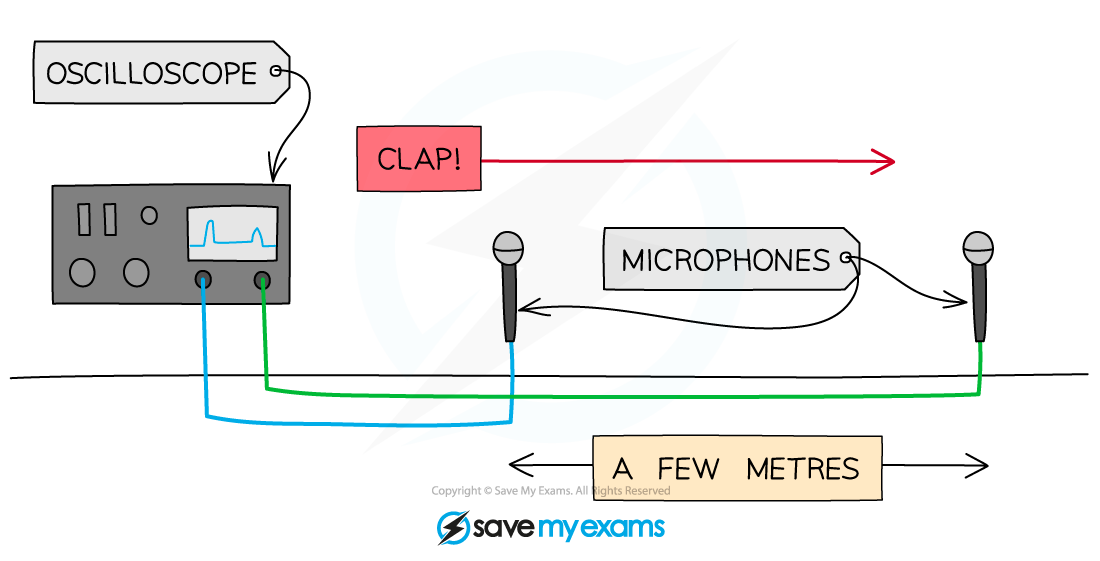Measuring Wave Speed
Experiments to Determine the Speed of Sound in Air
- There are several experiments that can be carried out to determine the speed of sound
- Three methods are described below
- The apparatus for each experiment is given in bold
Method 1: Measuring Sound Between Two Points

Measuring the speed of sound directly between two points
- Two people stand a distance of around 100 m apart
- The distance between them is measured using a trundle wheel
- One person has two wooden blocks, which they bang together above their head
- The second person has a stopwatch which they start when they see the first person banging the blocks together and stops when they hear the sound
- This is then repeated several times and an average value is taken for the time
- The speed of sound can then be calculated using the equation:

Method 2: Using Echoes

Measuring the speed of sound using echoes
- A person stands about 50 m away from a wall (or cliff) using a trundle wheel to measure this distance
- The person claps two wooden blocks together and listens for the echo
- The person then starts to clap the blocks together repeatedly, in rhythm with the echoes
- A second person has a stopwatch and starts timing when they hear one of the claps and stops timing 20 claps later
- The process is then repeated and an average time calculated
- The distance travelled by the sound between each clap and echo will be (2 × 50) m
- The total distance travelled by sound during the 20 claps will be (20 × 2 × 50) m
- The speed of sound can be calculated from this distance and the time using the equation:

Method 3: Using an Oscilloscope

Measuring the speed of sound using an oscilloscope
- Two microphones are connected to an oscilloscope and placed about 5 m apart using a tape measure to measure the distance
- The oscilloscope is set up so that it triggers when the first microphone detects a sound, and the time base is adjusted so that the sound arriving at both microphones can be seen on the screen
- Two wooden blocks are used to make a large clap next to the first microphone
- The oscilloscope is then used to determine the time at which the clap reaches each microphone and the time difference between them
- This is repeated several times and an average time difference calculated
- The speed can then be calculated using the equation:

Measuring the Speed of Ripples on Water Surfaces
Creating ripples in water
- Choose a calm flat water surface such as a lake or a swimming pool
- Two people stand a few metres apart using a tape measure to measure this distance
- One person counts down from three and then disturbs the water surface (using their hand, for example) to create a ripple
- The second person then starts a stopwatch to time how long it takes for the first ripple to get to them
- The experiment is then repeated 10 times and an average value for the time is calculated
- The average time and distance can then be used to calculate the wave speed using the equation:

Worked example
Small water waves are created in a ripple tank by a wooden bar. The wooden bar vibrates up and down hitting the surface of the water. The diagram below shows a cross-section of the ripple tank and water. Which letter shows:
Which letter shows:
a) The amplitude of a water wave?
b) The wavelength of the water wave?Part (a)
Step 1: Recall the definition of amplitude
- Amplitude = The distance from the undisturbed position to the peak or trough of a wave
Step 2: Mark the undisturbed position on the wave
- This is the centre of the wave

Step 3: Identify the arrow between the undisturbed position and a peak
- The amplitude is arrow D
Part (b)
Step 1: Recall the definition of wavelength
- Wavelength = The distance from one point on the wave to the same point on the next wave
Step 2: Draw lines on each horizontal arrow
- This helps to identify the points on the wave the arrows are referring to

Step 3: Identify the arrow between two of the same points on the wave
- The wavelength is arrow C
Exam Tip
When you are answering questions about methods to measure waves, the question could ask you to comment on the accuracy of the measurements
- In the case of measuring the speed of sound:
- Method 3 is the most accurate because the timing is done automatically
- Method 1 is the least accurate because the time interval is very short
Whilst this may not be too important when giving a method, you should be able to explain why each method is accurate or inaccurate and suggest ways of making them better (use bigger distances)
- For example, if a manual stopwatch is being used there could be variation in the time measured which can be up to 0.2 seconds due to a person's reaction time
- The time interval could be as little as 0.3 seconds for sound travelling in air
- This means that the variation due to the stopwatch readings has a big influence on the results and they may not be reliable


